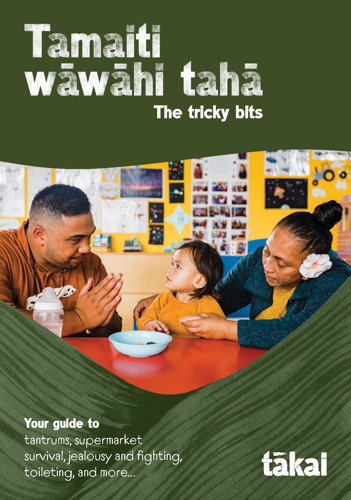
Learning to use the toilet
There is no single way for children to begin to use the toilet. Every child is different. The best thing parents can do is look for signs that the child is ready and stay calm.
At some time between 18 months and 4 years of age, most children show they are ready to start learning to use the toilet. It can be one of the trickiest stages of a child’s development for the whānau to deal with.
Having realistic expectations helps a lot, as does avoiding the temptation to compare their child’s progress with siblings or other similarly aged children. Because the timing for controlling bowel and bladder can vary so greatly, parents may be disappointed if they expect the same progress from them all.
It can be very frustrating, but if parents react to toileting ‘accidents’ in an angry way, their child can become nervous or fearful. This reaction won’t help their learning process.
Some people think that the later you start, the quicker it’s likely to happen. This relates to the long nerve cells connecting brain, bladder and bowel becoming fully ‘myelinated’, or covered in a fatty insulation, so messages travel efficiently between them. However, looking for ‘signs of readiness’ is probably of more help to parents than focusing on the specific age of their child. (See the further information below for more details about this.)
There are examples in some cultures of babies being helped to ‘toilet’ in their very early days. Dr Thomas Verny’s book called The Secret Life of the Unborn Child (1982) refers to mothers in rural areas of Africa who carry their newborns on their backs or slung on their sides and ‘sense’ when their baby has the urge to wee. Baby is then held out from their mum’s body to allow it to happen without any mess.
Many of our own grandparents here in Aotearoa would have been in the habit of ‘holding out’ their very young babies. Similarly to the African mamas, a young baby would be held over a potty or paper in a position that encouraged them to wee or poo.
A look back into some early Plunket books may find references to this practice. However, these traditions may not work for modern-day parents. Newborns and their parents are not usually in such close contact with each other, and babies are not always carried all day. That means parents are less likely to develop the sensitivity needed to read a young baby’s signals. Even the suggestion of introducing potty or toilet learning in a child’s early months would seem unusual to most families today.
A real key to helping with toileting at any age or stage is for the adults to be as calm and as matter of fact as they can, with neither a positive or negative response. At the end of the day, this is a naturally occurring human bodily function. What can influence a child’s feelings about it are the responses they receive from the people caring for them.
If every time a child has a dirty nappy changed and the person changing them pulls a face expressing disgust, it makes sense that a child will learn to consider that a natural bodily function is disgusting.
To learn how to use a toilet, a child needs to co-operate with their parents – this isn’t something parents can make their child do. But there are two key things that parents can do that will help a child to use the toilet:
- waiting to see some signs of readiness
- remaining calm.












